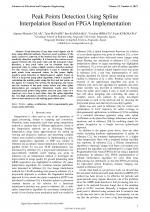| 4/2019 - 1 | View TOC | « Previous Article | Next Article » |
Peak Points Detection Using Spline Interpolation Based on FPGA ImplementationCOLAK, A. M. |
| Extra paper information in |
| Click to see author's profile in |
| Download PDF |
Author keywords
spline, architecture, field programmable gate arrays, peak, detection
References keywords
interpolation(13), spline(9), image(7), algorithm(7), processing(6), cubic(6), implementation(5), signal(4), fpga(4), computing(4)
Blue keywords are present in both the references section and the paper title.
About this article
Date of Publication: 2019-11-30
Volume 19, Issue 4, Year 2019, On page(s): 3 - 10
ISSN: 1582-7445, e-ISSN: 1844-7600
Digital Object Identifier: 10.4316/AECE.2019.04001
Web of Science Accession Number: 000500274700001
SCOPUS ID: 85077291662
Abstract
Peak detection of any time serial signals can be done using different methods. However, exact positions of the peaks cannot be achieved, if the method does not have a high sensitivity detection capability. It is known that various errors appear between the real peak value and the measured value; therefore, a true peak value can be obtained from the measured value by using a highly sensitive detection method. For this reason, spline interpolation is used to estimate the peak points from measured values. In this paper, highly sensitive peak detection of high-frequency signals based on FPGA is proposed using spline algorithm, which is capable of calculating the middle points using the first and last points on the signal. To evaluate the system, the histograms, the mean, and the variance of the peak values before and after spline interpolation are compared. Simulation results show that calculated peak points using splines and real peak values of a signal are very close to each other since the spline algorithm has very high calculation sensitivity. In addition, spline results show us how much error the existing peak values have. |
| References | | | Cited By |
Web of Science® Times Cited: 0
View record in Web of Science® [View]
View Related Records® [View]
Updated today
SCOPUS® Times Cited: 0
View record in SCOPUS® [Free preview]
There are no citing papers in the CrossRef Cited-by Linking system.
Disclaimer: All information displayed above was retrieved by using remote connections to respective databases. For the best user experience, we update all data by using background processes, and use caches in order to reduce the load on the servers we retrieve the information from. As we have no control on the availability of the database servers and sometimes the Internet connectivity may be affected, we do not guarantee the information is correct or complete. For the most accurate data, please always consult the database sites directly. Some external links require authentication or an institutional subscription.
Web of Science® is a registered trademark of Clarivate Analytics, Scopus® is a registered trademark of Elsevier B.V., other product names, company names, brand names, trademarks and logos are the property of their respective owners.
Faculty of Electrical Engineering and Computer Science
Stefan cel Mare University of Suceava, Romania
All rights reserved: Advances in Electrical and Computer Engineering is a registered trademark of the Stefan cel Mare University of Suceava. No part of this publication may be reproduced, stored in a retrieval system, photocopied, recorded or archived, without the written permission from the Editor. When authors submit their papers for publication, they agree that the copyright for their article be transferred to the Faculty of Electrical Engineering and Computer Science, Stefan cel Mare University of Suceava, Romania, if and only if the articles are accepted for publication. The copyright covers the exclusive rights to reproduce and distribute the article, including reprints and translations.
Permission for other use: The copyright owner's consent does not extend to copying for general distribution, for promotion, for creating new works, or for resale. Specific written permission must be obtained from the Editor for such copying. Direct linking to files hosted on this website is strictly prohibited.
Disclaimer: Whilst every effort is made by the publishers and editorial board to see that no inaccurate or misleading data, opinions or statements appear in this journal, they wish to make it clear that all information and opinions formulated in the articles, as well as linguistic accuracy, are the sole responsibility of the author.





